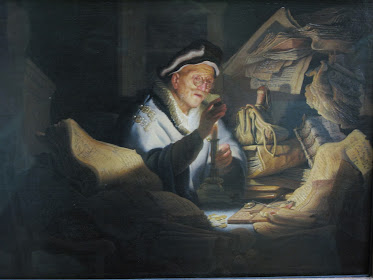Howard Thurman and the Quest for Community: From Prodigals to Compassionate Samaritans
This post is the first on chapter 6, the second chapter about the Prodigal Son parable. It includes a sermon from Howard Thurman and a discussion of this painting by Frank Wesley.
Frank Wesley was born in Azamgarh, India, on December 12, 1923. Wesley became the best-known Christian Indian artist of his day (e.g., his 1947 Blue Madonna was selected for the UNICEF Christmas card, several other works won awards and honors, and his design was selected for the urn that held Mahatma Gandhi’s ashes before they were immersed at the confluence of the Ganges and Jumna rivers). Wesley painted Forgiving Father while at Kyoto Art University in Japan (1954–1958), but the painting retains the cultural symbolism of Indian and Hindu social practice. The Brahmin father, dressed in white, welcomes his son home, his left hand holding his son’s back, his loving right hand caressing his son’s head, and his head bowed into his son’s neck (Wesley was influenced by Rembrandt; cf. the etching by Rembrandt and his famous painting in the Hermitage Museum). The emaciated son is too weak to stand on his own and depends on the father to hold him up, his right hand responding to his father’s love by clasping his father’s arm. Note the color contrasts—the people, clothes, and background—especially how the color of the clothes of the son and his loving father begin to merge as our eyes move downward (see Wray 1993).
The simplicity but profoundness of this painting makes it fertile ground for “slow looking” explorations of how this painting works, what it means, and what it wants. For Wesley, the father symbolizes God and the son humanity: God is present unconditionally seeking to reconcile with sinful humanity. The son, like humankind, is unable to stand on his own without the loving support of his father (Wray 1993, 44). Other interpreters argue that the son looks and dresses like a Dalit, the lowest and most oppressed social level in India, in contrast to his father’s appearance as a Brahmin, the highest caste. Some interpreters also argue that the father resembles Mahatma Gandhi.
HOWARD THURMAN AUDIO
In his sermon, “Salvation: What Is God Like?” (September 16, 1951), Thurman observes that the lost sheep and lost coin parables have profound implications about the nature of God, human beings, and the relationship between human beings and God. The lost sheep parable, for example, portrays God as a shepherd who loves and seeks out the lost sheep, those who are out of touch “with the group that sustained” them. In reality, Thurman says, “everyone in some sense is lost,” and so God takes the initiative, actively searches for the lost, and seeks to restore them to the community in which they belong.
The next post (on chapter 6, part 2) will focus on some key quotes from the chapter and some other resources.







